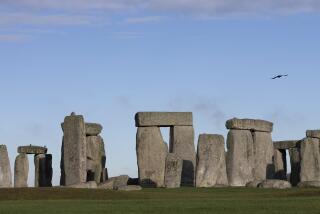Rosetta Stone Retains Its Ancient Air of Mystery
- Share via
LONDON — The Rosetta Stone unlocked one of the world’s great mysteries by providing a key to the meaning of Egyptian hieroglyphics.
And 200 years later, there are still things to learn about the slab of rock that is one of the world’s cultural icons.
“The wretched thing springs surprises on us all the time,” said Richard Parkinson, who organized an exhibition at the British Museum to celebrate the bicentenary of the discovery.
“Wretched” was offered tongue in cheek, for Parkinson clearly relishes the remaining mysteries of the stone--even if none is anywhere near the scale of the big question it answered.
The stone is a large fragment of a stela, a sort of tombstone-shaped slab, which was placed in a temple of Ptolemy. It was written in three versions: hieroglyphics, an Egyptian script called “demotic” and Greek.
The Rosetta Stone has entered the language as a symbol for an intellectual breakthrough, like Archimedes’ bath or Newton’s apple.
However, the discovery of the stone by French soldiers in 1799 did not provide an instant translation of hieroglyphics. That labor took two decades, with the largest credit going to Thomas Young of England and Jean-Francois Champollion of France.
The Rosetta Stone became English property when the French surrendered to the English in Egypt two years after finding the stone.
During recent conservation work, Parkinson said traces of pink pigment were found in the symbols on the stone. Specialists haven’t determined whether the pigment is ancient or was used by the French scholars who first worked on the stone.
They also don’t know exactly where the stela was placed in the temple, Parkinson noted, although there are indications that it was against a mud wall in the outer part of the building.
The significance of that question has to do with who was intended to read the stone--an elite with access to the inner temple or a wider audience. If the pigment proves to be ancient, that also would support the notion that the stone was inside the temple, because the pigment would make the inscription visible in low light.
Questions also remain whether the inscription was written first in Egyptian or in Greek.
“Most people now agree it was composed simultaneously--at a sort of fractious committee meeting of courtiers and priests,” Parkinson said.
The exhibition, which runs through Jan. 16, makes the point that the work of interpreting the stone--and the culture that produced it--goes on.
“The decipherment of the Egyptian scripts is not a single event that occurred in 1822, when a code was cracked, but is a continuous process that is repeated at every reading of a text or artifact,” cryptanalyst Whitfield Diffie and Egyptologist Mary Fischer write in the exhibition catalog.
“Such study is the closest one can come to speaking with the dead. Like any act of reading, it is a process of dialogue. The decipherment of the Rosetta Stone and of ancient Egypt is a dialogue that has scarcely begun.”
More to Read
The biggest entertainment stories
Get our big stories about Hollywood, film, television, music, arts, culture and more right in your inbox as soon as they publish.
You may occasionally receive promotional content from the Los Angeles Times.









